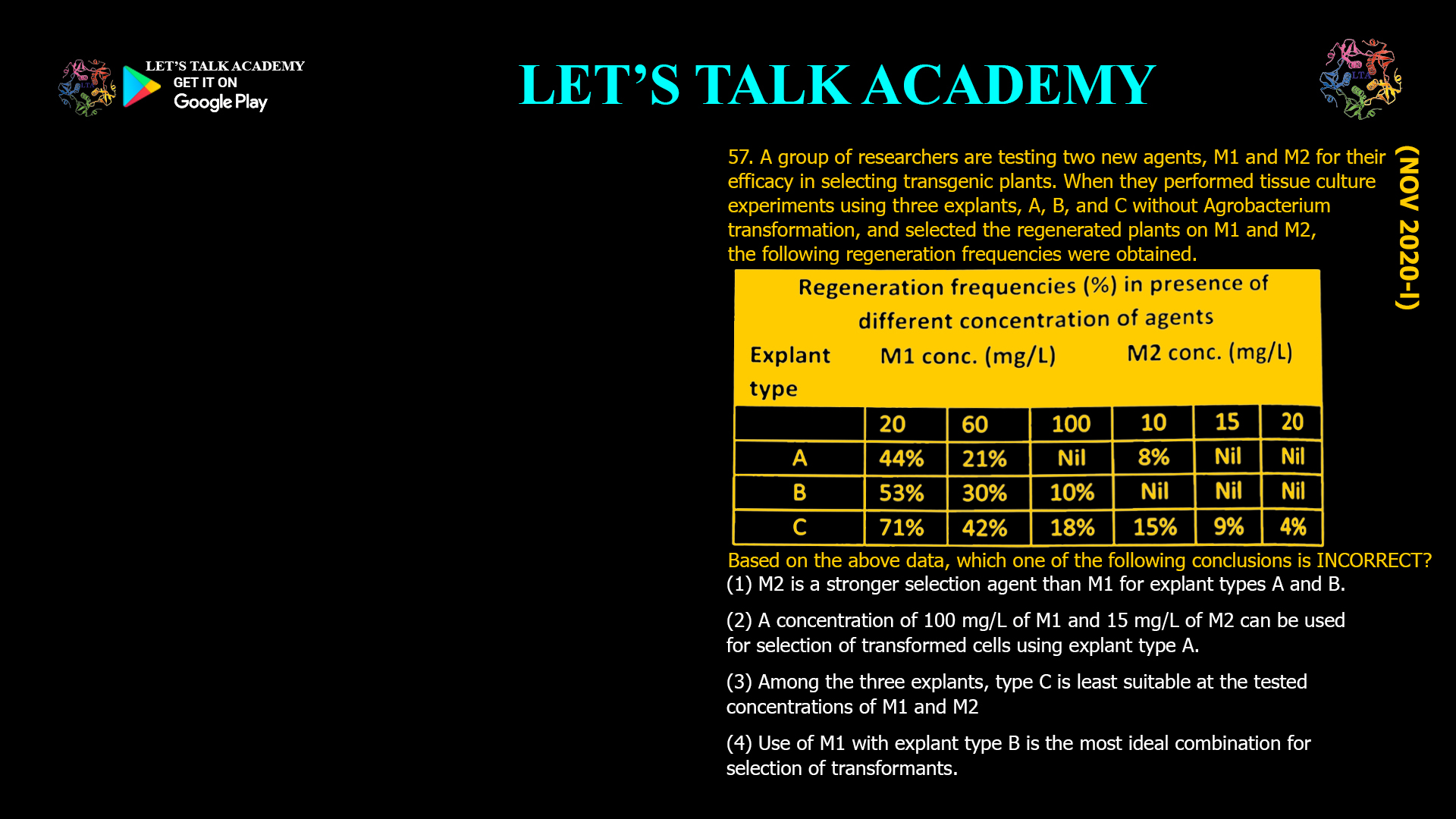- A group of researchers are testing two new agents, M1 and M2 for their efficacy in selecting transgenic plants. When they performed tissue culture experiments using three explants, A, B, and C without Agrobacterium transformation, and selected the regenerated plants on M1 and M2, the following regeneration frequencies were obtained.
Based on the above data, which one of the following conclusions is INCORRECT?
(1) M2 is a stronger selection agent than M1 for explant types A and B.
(2) A concentration of 100 mg/L of M1 and 15 mg/L of M2 can be used for selection of transformed cells using explant type A.
(3) Among the three explants, type C is least suitable at the tested concentrations of M1 and M2
(4) Use of M1 with explant type B is the most ideal combination for selection of transformants.The incorrect conclusion is (3) “Among the three explants, type C is least suitable at the tested concentrations of M1 and M2.”
From the table (regeneration % without Agrobacterium, hence reflecting toxicity of selection agents):
-
M1 (mg/L)
-
A: 44% (20), 21% (60), 0% (100)
-
B: 53% (20), 30% (60), 10% (100)
-
C: 71% (20), 42% (60), 18% (100)
-
-
M2 (mg/L)
-
A: 8% (10), 0% (15, 20)
-
B: 0% at all tested M2 levels
-
C: 15% (10), 9% (15), 4% (20)
-
Lower regeneration of non-transformed cells at a given concentration means stronger selection (better killing of escapes).
Analyse each conclusion
(1) “M2 is a stronger selection agent than M1 for explant types A and B.” – Correct
-
For A, at roughly comparable “mid” doses: 60 mg/L M1 → 21% regeneration; 10 mg/L M2 → 8%. M2 at just 10 mg/L kills more cells than M1 at 60 mg/L, so it is stronger.
-
For B, M2 gives 0% regeneration at all tested concentrations, while M1 still allows 10–53% regeneration. So M2 is clearly stronger for B.
Hence statement 1 is correct.
(2) “100 mg/L M1 and 15 mg/L M2 can be used for selection of transformed cells using explant type A.” – Correct
-
For A, M1 at 100 mg/L and M2 at 15 mg/L both give 0% regeneration of non‑transformed cells.
-
In a real transformation, only transformed cells carrying resistance genes would survive at these levels, making them good selection doses for explant A.
So statement 2 is also correct.
(3) “Among the three explants, type C is least suitable at the tested concentrations of M1 and M2.” – Incorrect
Suitability refers to finding a window where:
-
non‑transformed cells are killed efficiently, but
-
there is still some regeneration (i.e., the tissue tolerates the agent when resistant).
Looking at non‑transformed data:
-
Explant B is actually the most sensitive to M2 (0% regeneration at all tested M2 concentrations) and quite sensitive to M1 at high dose.
-
Explant C shows intermediate regeneration on M1 and some on all M2 concentrations (4–18%), meaning it is not the least suitable; if anything, it gives a usable gradient of responses.
Thus conclusion 3 misinterprets the data and is the incorrect statement.
(4) “Use of M1 with explant type B is the most ideal combination for selection of transformants.” – Reasonable / Correct
-
With B + M1, there is a nice titration: 53% → 30% → 10% regeneration as M1 increases.
-
This indicates B tissue is sensitive, but not dead at moderate M1, allowing selection dose optimization and likely good discrimination between resistant (transgenic) and non‑transgenic cells.
-
With B + M2, everything is dead at all doses, leaving no window; with A or C, the responses are either too tolerant or require higher doses.
So B with M1 indeed looks like the most practical combination for fine‑tuning selection.
Why option (3) is the answer
-
Statements (1), (2), and (4) are supported by the regeneration percentages.
-
Statement (3) wrongly labels explant C as “least suitable,” even though its response profile is not the worst and B with M2 is clearly more problematic.
Therefore, the incorrect conclusion is option (3).
SEO‑oriented introduction (for article use)
When comparing new selection agents M1 and M2 using different explants (A, B, C), regeneration percentages of non-transformed tissues reveal how strong each agent is and which explant–agent combination is best for selecting transformants. M2 is more potent than M1 for A and B, 100 mg/L M1 and 15 mg/L M2 effectively eliminate non-transgenic A cells, and explant B with M1 offers the best selection window, whereas labelling explant C as the “least suitable” is not supported by the data.
-



